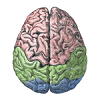9.3: Reading and Dyslexia in the Triangle Model
- Page ID
- 12617
The first language model we explore simulates the major pathways involved in reading, according to the so-called triangle model (Figure 9.6) (cite: Plaut & Shallice, ??). This model provides a basic understanding of the functional roles of visual perception of written words (orthography), spoken motor output of word phonology, and semantic representations of word meaning in between. This set of language pathways is sufficient to simulate the processes involved in reading words aloud, and damage to these pathways can simulate the critical features of different types of acquired dyslexia. Acquired dyslexia, which results from strokes or other brain damage, is distinct from developmental dyslexia, which is the more common form that many people associate with the term dyslexia (which generically refers to any form of reading impairment).

There are three major forms of acquired dyslexia that can be simulated with the model:
- Phonological -- characterized by difficulty reading nonwords (e.g., "nust" or "mave"). This can be produced by damage to the direct pathway between orthography and phonology (there shouldn't be any activation in semantics for nonwords), such that people have difficulty mapping spelling to sound according to learned regularities that can be applied to nonwords. We'll explore this phenomenon in greater detail in the next simulation.
- Deep -- is a more severe form of phonological dyslexia, with the striking feature that people sometimes make semantic substitutions for words, pronouncing the word "orchestra" as "symphony" for example. There are also visual errors, so-named because they seem to reflect a misperception of the word inputs (e.g, reading the word "dog" as "dot"). Interestingly, we'll see how more significant damage to the direct pathway can give rise to this profile -- the semantic errors occur due to everything going through the semantic layer, such that related semantic representations can be activated. In the normal intact brain, the direct pathway provides the relevant constraints to produce the actual written word, but absent this constraint, an entirely different but semantically related word can be output.
- Surface -- here nonword reading is intact, but access to semantics is impaired (as in Wernicke's aphasia), strongly implicating a lesion in the semantics pathway. Interestingly, pronunciation of exception words (e.g., "yacht") is impaired. This suggests that people typically rely on the semantic pathway to "memorize" how to pronounce odd words like yacht, and the direct pathway is used more for pronouncing regular words.

That these different forms of dyslexia can be reliably observed in different patients, and fit so well with expected patterns of reading deficits according to the triangle model, provides a strong source of support for the validity of the model. It would be even more compelling if the specific foci of damage associated with these different forms of dyslexia make sense anatomically according to the mapping of the triangle model onto brain areas. todo: see if the data is there or not!
Exploration
- Open Dyslexia for the simulation of the triangle model and associated forms of dyslexia. This model allows you to simulate the different forms of acquired dyslexia, in addition to normal reading, using the small corpus of words as shown in Figure 9.7. In the next section, we expand upon the direct pathway and examine nonword reading, which requires a much larger corpus of words to acquire the relevant statistical regularities that support generalization.
See Dyslexia Details for detailed graphs of the effects of partial lesions to the different pathways within the triangle model -- you can reproduce this data in the simulation, but the graphs provide a much clearer overall visualization of the results. The qualitative patterns produced by complete lesions of either the direct or semantic pathway hold up quite well over the range of partial damage.


